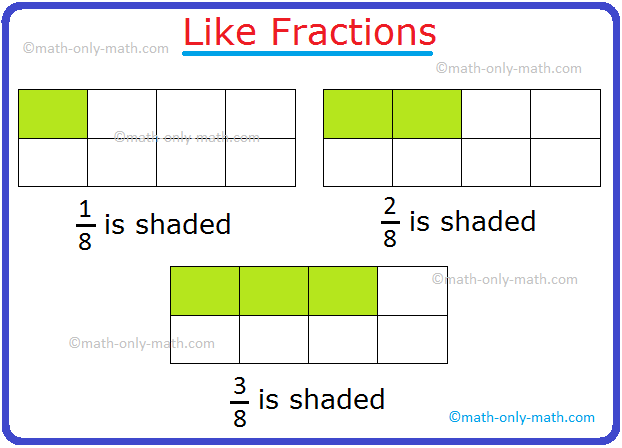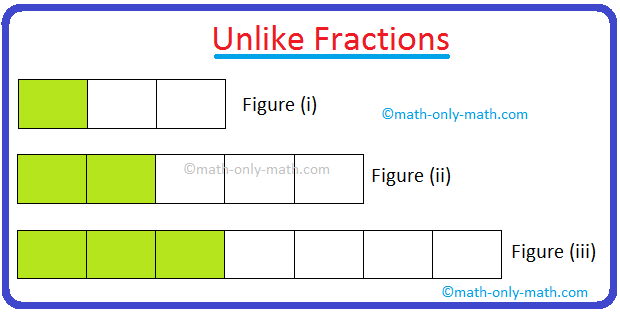Subscribe to our ▶️ YouTube channel 🔴 for the latest videos, updates, and tips.
Like and Unlike Fractions
Like and unlike fractions are the two groups of fractions:
(i) 1/5, 3/5, 2/5, 4/5, 6/5
(ii) 3/4, 5/6, 1/3, 4/7, 9/9
In group (i) the denominator of each fraction is 5, i.e., the denominators of the fractions are equal.
The fractions with the same denominators are called like fractions.
In group (ii) the denominator of each fraction is different, i.e., the denominators of all the fractions are different.
The fractions with different denominators are called unlike fractions.
Examples of like fractions are:
(a) (2/9, 3/9, 5/9, 9/9);
(b) (3/10, 7/10, 1/10, 9/10);
(c) (1/7, 2/7, 4/7, 5/7, 7/7)
Examples unlike fractions are:
(a) (1/2, 1/4, 2/3, 5/6)
(b) (3/8, 2/3, 3/5, 2/7)
(c) (1/9, 2/7, 3/4, 2/5).
Like Fractions:
Observe the
following figures.
The
fraction \(\frac{1}{8}\), \(\frac{2}{8}\), \(\frac{3}{8}\) have the same
denominator. Such fractions are called like fractions.
Unlike Fractions:
In figure (i) one part is shaded out of 3 parts, the fraction represented is \(\frac{1}{3}\).
In figure (ii) has two parts shaded out of 3 parts, the fraction represented is \(\frac{2}{5}\).
In figure (iii) we have three parts shaded out of 7 parts, the fraction represented is \(\frac{3}{7}\).
The fraction \(\frac{1}{3}\), \(\frac{2}{5}\), \(\frac{3}{7}\) have different denominators. Such fractions are called unlike fractions.
Worksheet on Like and Unlike Fractions:
1. Which of the following is a set of like fractions?
|
(i) \(\frac{1}{9}\), \(\frac{5}{9}\), \(\frac{4}{9}\), \(\frac{11}{9}\) (iii) \(\frac{4}{11}\), \(\frac{5}{8}\), \(\frac{7}{9}\), \(\frac{1}{7}\)
|
(ii) \(\frac{1}{7}\), \(\frac{2}{8}\), \(\frac{4}{19}\), \(\frac{7}{6}\) (iv) \(\frac{4}{11}\), \(\frac{5}{8}\), \(\frac{7}{9}\), \(\frac{1}{7}\)
|
Answer:
1. (i) First set is like fractions because denominators are the same.
2. Which of the following is a set of unlike fractions?
|
(i) \(\frac{1}{13}\), \(\frac{13}{15}\), \(\frac{15}{17}\), \(\frac{17}{19}\) (iii) \(\frac{4}{16}\), \(\frac{1}{16}\), \(\frac{2}{16}\), \(\frac{9}{16}\)
|
(ii) \(\frac{4}{12}\), \(\frac{5}{12}\), \(\frac{8}{12}\), \(\frac{9}{12}\) (iv) \(\frac{8}{9}\), \(\frac{1}{7}\), \(\frac{7}{8}\), \(\frac{8}{11}\)
|
Answer:
2. (i) First and fourth sets are unlike fractions because denominators are not the same
You might like these
To convert a percentage into a fraction, place the given number over 100 and reduce it to its lowest term. Consider the following example: (i) 20% [We know % = 1/100]
To convert a mixed number into an improper fraction, we multiply the whole number by the denominator of the proper fraction and then to the product add the numerator of the fraction to get the numerator of the improper fraction. I
In conversion of improper fractions into mixed fractions, we follow the following steps: Step I: Obtain the improper fraction. Step II: Divide the numerator by the denominator and obtain the quotient and remainder. Step III: Write the mixed fraction
To add two or more like fractions we simplify add their numerators. The denominator remains same. Thus, to add the fractions with the same denominator, we simply add their numerators and write the common denominator.
In 5th Grade Fractions Worksheets we will solve how to compare two fractions, comparing mixed fractions, addition of like fractions, addition of unlike fractions, addition of mixed fractions, word problems on addition of fractions, subtraction of like fractions
Here we will solve different types of word problems on multiplication and division of fractions. I. Solve the following word problems on multiplication of fractions.
In properties of multiplication and division of fractions worksheet you will get different types of questions based on properties of multiplication of fractional numbers and properties of division of fractional numbers.
In word problems on fraction we will solve different types of problems on multiplication of fractional numbers and division of fractional numbers.
In worksheet on fractions, all grade students can practice the questions on fractions on a whole number and also on representation of a fraction. This exercise sheet on fractions can be practiced
In worksheet on word problems on fractions we will solve different types of word problems on multiplication of fractions, word problems on division of fractions etc... 1. How many one-fifths
Concept of fractions will help us to express different fractional parts of a whole. One-half When an article or a collection of objects is divided into two equal parts is called as half of the whole.
How to find fraction as a part of collection? Let there be 14 rectangles forming a box or rectangle. Thus, it can be said that there is a collection of 14 rectangles, 2 rectangles in each row. If it is folded into two halves, each half will have 7 rectangles. So, we can say
Representation of a fraction is discussed here. In a simple fraction, there is a horizontal line. Above this line we write a number which is called the numerator. Below this line we write another number which is called the denominator.
We will discuss here about the identification of the parts of a fraction. We know fraction means part of something. Fraction tells us, into how many parts a whole has been
How to find a fraction of a whole number? For finding a fraction of a whole number, we multiply the numerator of the fraction by the given number and then divide the product by the denominator
Related Concept
● Fraction
of a Whole Numbers
● Representation
of a Fraction
● Equivalent
Fractions
● Properties
of Equivalent Fractions
● Like and
Unlike Fractions
● Comparison
of Like Fractions
● Comparison
of Fractions having the same Numerator
● Types of
Fractions
● Changing Fractions
● Conversion
of Fractions into Fractions having Same Denominator
● Conversion
of a Fraction into its Smallest and Simplest Form
● Addition
of Fractions having the Same Denominator
● Subtraction
of Fractions having the Same Denominator
● Addition
and Subtraction of Fractions on the Fraction Number Line
4th Grade Math Activities
From Like and Unlike Fractions to HOME PAGE
Didn't find what you were looking for? Or want to know more information
about Math Only Math.
Use this Google Search to find what you need.
Share this page:
What’s this?


![To convert a percentage into a fraction, place the given number over 100 and reduce it to its lowest term. Consider the following example: (i) 20% [We know % = 1/100]](/image-thumbnails/convert-a-percentage-into-a-fraction.png/default.webp)














New! Comments
Have your say about what you just read! Leave me a comment in the box below. Ask a Question or Answer a Question.